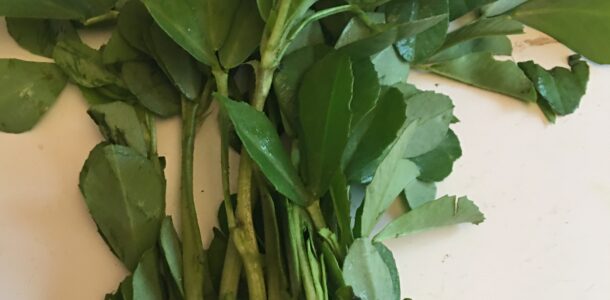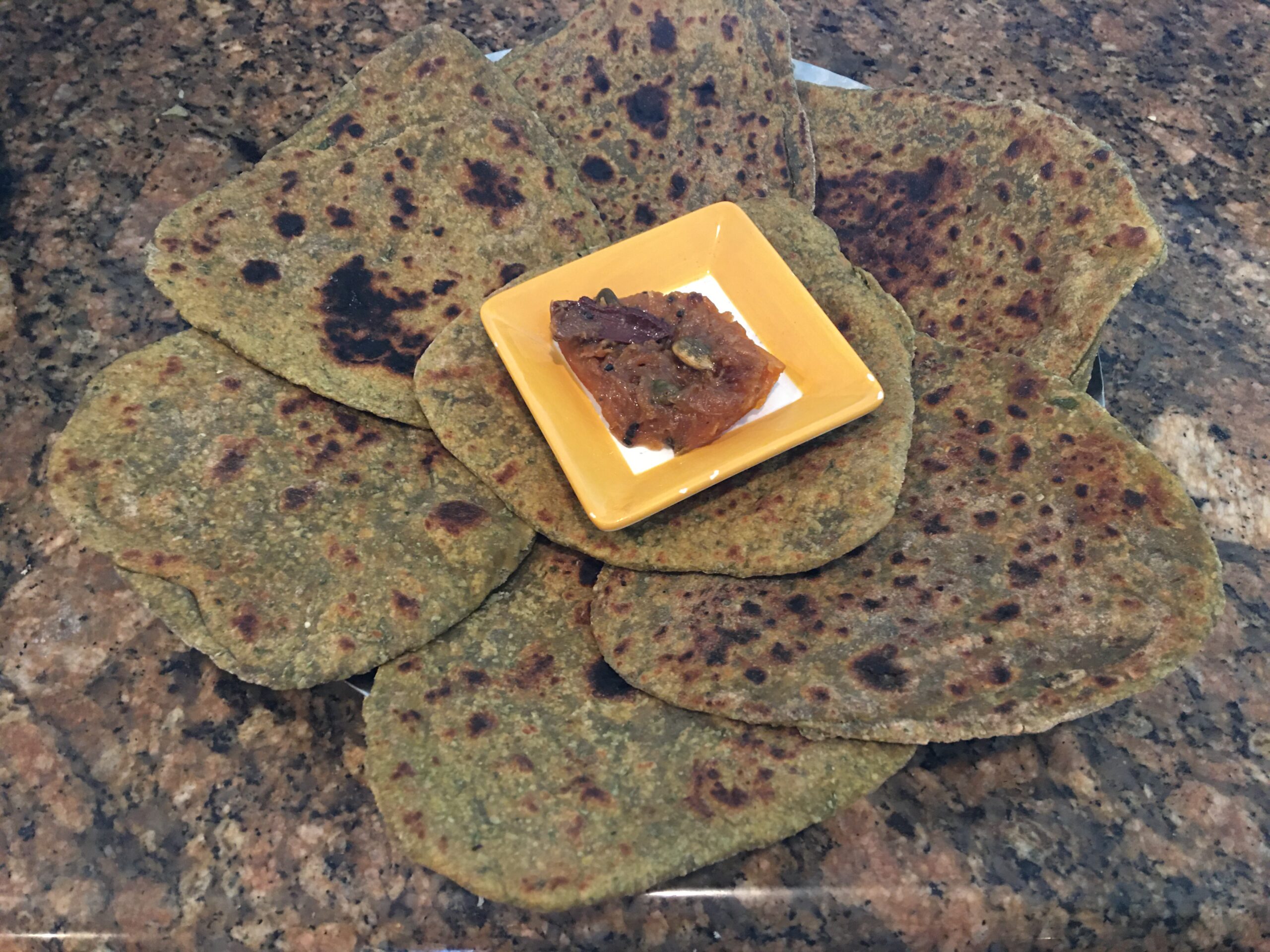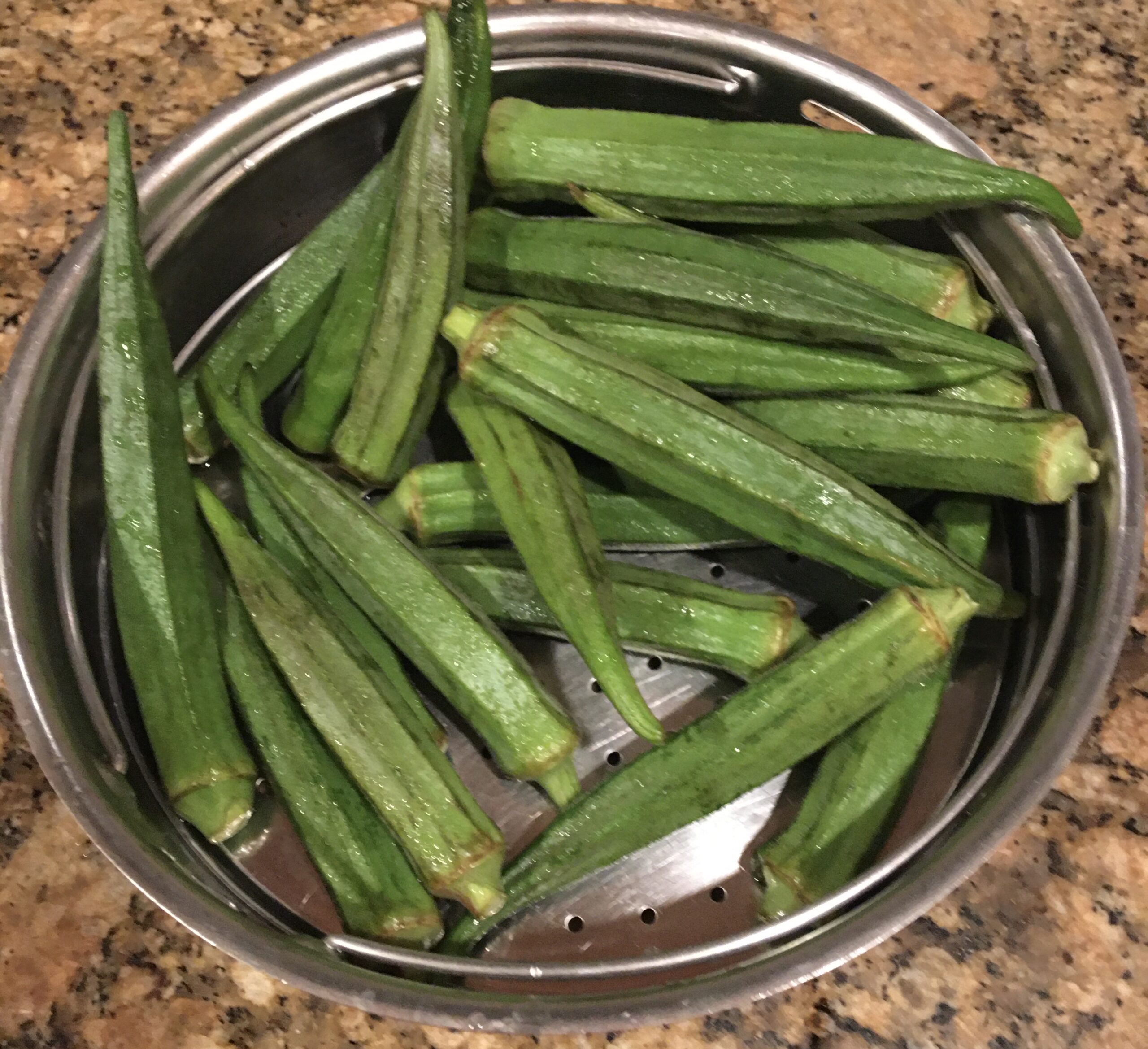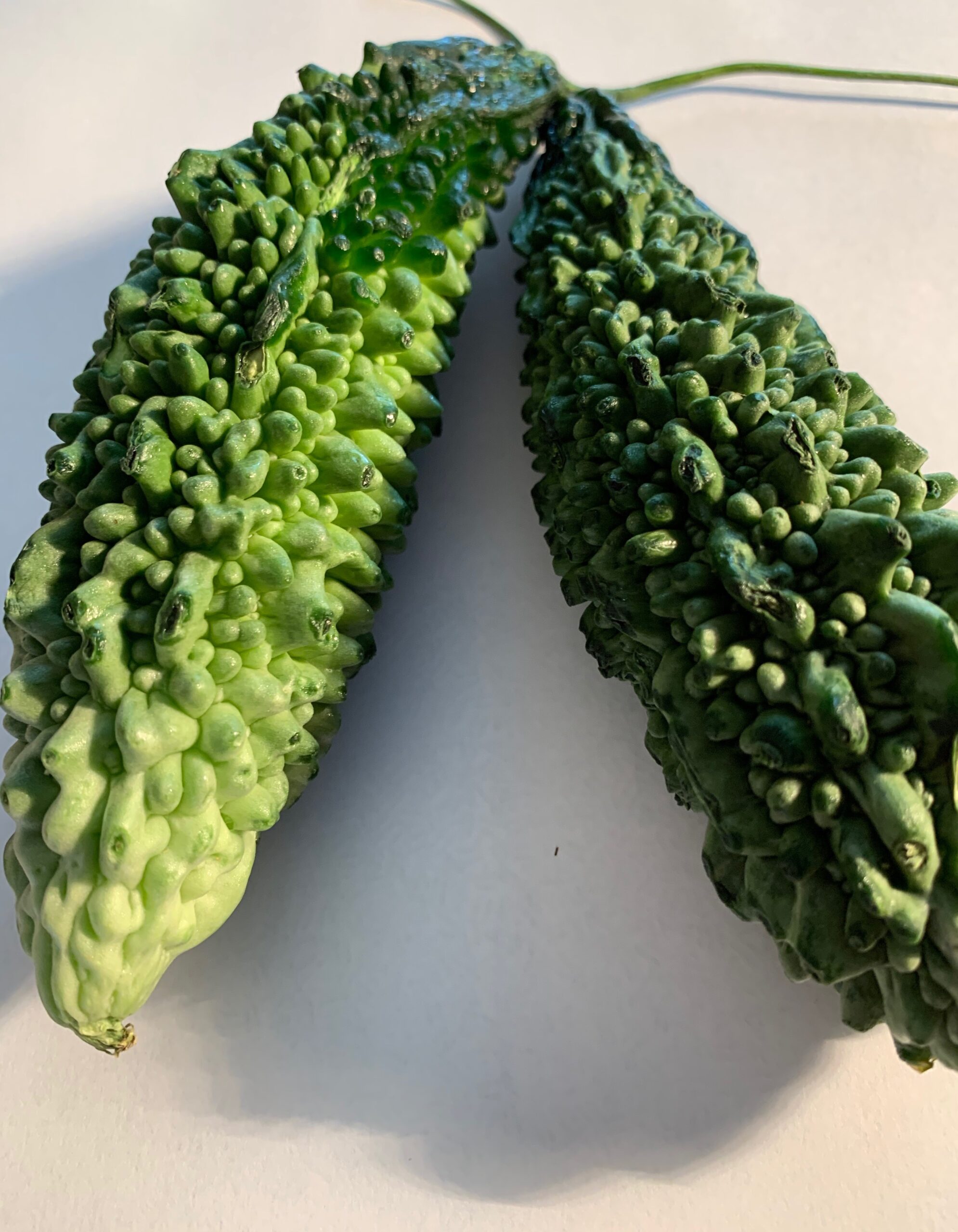Fenugreek leaf is one of the most widely used green leafy vegetables. Its plant is an erect 2-3 foot tall annual herb with light green leaves and small white flowers that looks like clover. The leaves are used to make methi parothas, muthias, and subzee with onions, potatoes, carrots or tomatoes.
Fenugreek seed : The seed pod contains 10-20 small, flat, yellowish brown pungent aromatic seeds. The seeds have a strong aroma and slightly bitter to taste similar to celery, maple syrup or caramel. Methi seeds are roasted and powdered (mellows its bitterness) for making sauces like sambhar and to preserve pickles.
Culinary uses: Fenugreek is cooked in 3 forms leaves (fresh & dried) and seeds. The leaves give a nice lift to bland vegetarian dishes. The dried leaves are used in hot oil with mustard seeds to uplift flavor. Young shoots along with water cress make a good salad addition.
Other uses: Fenugreek seed extract is used in imitation vanilla and maple syrup, butter scotch and rum flavorings. Also used in breads in Egypt and Ethiopia. Fenugreek seeds are also used in candy, baked goods, ice cream, chewing gum, and soft drinks.
Buying & Storage: Pick bunches of Fenugreek leaves with no yellow in them. Store Fenugreek leaves in a cool dry place. Wrap leaves in paper towels to absorb moisture. The leaves can be sun dried and stored for 6 months.
History: Fenugreek has a long history as a medicinal and culinary herb in the ancient world. It was one of the spices used by Egyptians for embalming. Both Greeks and Romans used it as fodder for cattle. Hence the Latin name “Foenum Graecum” meaning Greek hay. It was grown in the Imperial gardens of Charlmagne in large fields. It is native to the Mediterranean region, southern Europe and Western Asia. It is known by many names : Alholva, Chandrika, HuluBa, Methi, Trigonella,
http://www.foodreference.com/html/artfenugreek.html
Fenugreek Leaf Recipes
Fenugreek leaves Dumplings (Methi Muthia)
Fenugreek leaves with potatoes (Aloo Methi)
Fenugreek leaves Fritters (Methi Pakoras)
Nutrition facts of Fenugreek leaves
(Trigonella Foenum -gracum)
| GI = 15; GL =0 | Minerals | Vitamins % RDA |
| Energy 50 kcal | Sodium 67mg | Vitamin A 302mcg – 34% |
| Carb 58g – 25.9% | Potassium770 mg – 14% | Riboflavin 0.28 mg – 2% |
| Protein 23 g 25% | Calcium 110mg – 8% | Vitamin B6 30% |
| Fat 6 g | Iron 2.5mg – 186% | Vitamin C 55.2 mg- 61% |
| Fiber 12.9% | Magnesium 59mg – 47% | Lipids 6.5% |
| gum 10.8% | Copper 0.26mg | Ash 10.8% |
How to use Fenugreek leaves
- Fenugreek Tea: 1 tsp. Dried Fenugreek leaves; 1 cup water. Boil leaves with water; close with lid; let leaves settle; strain with a tea filter. (Use every day)
- Mouth Freshener : 1/2 tsp. fenugreek leaves powder; 2 cups water; juice of 1/2 lemon ; Boil water add fenugreek leaf powder. Mix and let settle. Strain liquid and add lemon juice (Use every day )
- Reduction of blemishes : Make paste of the 1 cup fenugreek leaves with1/2 cup water. Apply on the face and leave for 15 minutes and wash off. (Use twice a week)
- Long and Healthy Hair : Make a paste of 1 cup fenugreek leaves with 1/2 cup water and applu on scalp. Leave for 40 min. Wash off. (Use once a week)
- {Caution : not for pregnant moms as it may induce labor; If applying fenugreek leaves topically on face or scalp do a patch test for allergies}
https://stylesatlife.com/articles/fenugreek-leaves-benefits/
Health benefits of Fenugreek leaves
- Anti cancer potential: The steroid diosgenin present in fenugreek has been specifically linked to colon cancer prevention.
- Controls Diabetes : fenugreek recommended for daily blood sugar control contains Galactomannan, a natural fiber that is able to slow down the rate at which sugar is absorbed in the bloodstream. Fenugreek has the amino acid (4-hydroxylsoleucine) which induces the production of insulin (15 – 20 g)
- Treats bowel issues : Eases constipation – fiber content in the leaf provides roughage for easy excretion of waste material from the body.
- Helps curb fever and relieve sore throat.
- Lowers Cholesterol levels: Fenugreek consumption has the efficacy in helping reduce LDL cholesterol levels. By reducing cholesterol in the blood stream you lower the risk of formation of clots.
- Minimizes symptoms of menopause: Fenugreek leaves manage menopause symptoms by inhibiting the excess activity of testosterone.
- Promotes hair growth giving luxurious hair and removes blemishes from skin.
- Promotes lactation: Adding fenugreek tea in the diet can help with increasing lactation in new mothers.
- Reduces Menstural discomfort: Fenugreek seeds help reduce menstural pain.
- Reduces cardiovascular risks: prevent heart attacks and strokes.
- Protects from Kidney problems: Reduces the amount of calcification in kidneys.
- Weight loss – Satiates appetite : The natural fiber Galactomann found in fenugreek helps suppress appetite by making you feel full.
- Spinach Health Benefits:
100 g provides 9376 IU of vitamin A – 188% of RDA. Zeaxanthin a dietary carotenoid, is partially absorbed into the eyes to prevent macular degeneration and to provide protective light filtering properties. Lutein improves eye function and degeneration of the retina. it also reduces tension in the eyes by accumulating in the eye tissues.
- Cilantro leaves Health Benefits:
may help reduce LDL(bad) cholesterol in blood with good amounts of antioxidants, essential oils, vitamins and fiber.
- Mint leaves Health Benefits :
improve dental health: chewing on mint leaves is helpful for alleviating pain from toothaches. Mint contains Chlorohexidene a potent anti microbial compound prevents bacteria that cause tooth decay and bad breath.
Spice & Herb Power
- Tawa fry masala: enhances nutrient absorption. Cardamom is rich in antioxidants with properties to regulate blood pressure and reduce inflammation. Nutmeg has a compound called macelignan that can kill bacteria causing tooth decay.
- Ginger paste : treats upset stomach and motion sickness. It relieves nausea and vomiting after surgery, in cancer patients undergoing chemo therapy and pregnant women suffering from morning sickness.
- Garlic paste : Garlic works as a blood thinner, preventing heart attacks and strokes. The polysulfide in garlic reduce the buildup of plaque in artery walls, promote widening of blood vessels ,thereby reducing blood pressure.
- Green chili paste: a natural source of iron, recommended for iron deficiency and also considered good for eyesight.
Method to make Fenugreek Leaves Muthias
This Muthia dish is a leaf bonanza combining spinach with Fenugreek, cilantro and mint to make delicious vegetarian balls in a savory tomato gravy with spices. Steamed Muthias are healthier than fried koftas or pakoras.
- To make Muthias
Chop spinach, fenugreek, cilantro and mint leaves in a food processor. Crumble cottage cheese; mix with salt, tawa fry masala and leaves. Add flours; mix with sufficient water to make dough; shape into 1″ balls. (5 min.) Place the balls on a greased perforated plate of a steamer. Add water in steamer; steam until the balls are not sticky. Test with a fork, should come out clean. (10 min.)
- To make Gravy Heat the oil in a frying pan. Add pastes and onion puree; stir fry. (2 min) Add salt, tomato puree and bring to a boil. Place Muthias in gravy and simmer. (5 min.) Garnish with fried cashews.
- Serve Steamed Muthias with Quinoa, Veggie Pilaf, Pita bread, Naan, or Parathas.
TIPS
Onion puree : chop one onion and puree with a little water in blender
Save time : Substitute fresh leaves with frozen spinach & fenugreek leaves
Store bought paneer can be stored in the freezer for 3 months
Variation: Substitute paneer with TOFU(Soy bean curd for VEGANS)
To make Tawa fry masala : Combine 1/2 tsp each powder and assemble turmeric , red chili, asafetida, pomegranate, chaat masala, amchur , cardamom, cinnamon, nutmeg, garam masala, coriander and roasted cumin









